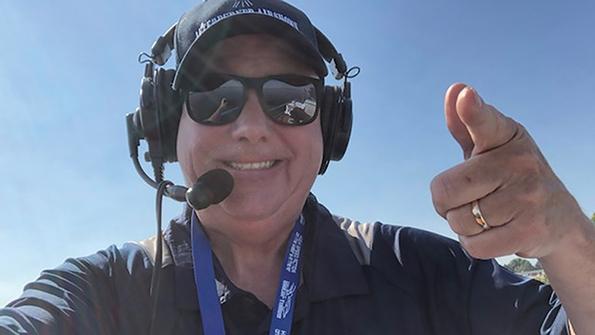
His is a career inspired by a blizzard and the Boeing Superfortress.
Teenager Bill Walsh was riveted watching TV weathermen assess the massive 1978 winter storm that delivered record snow and ice to his Pawtucket, Rhode Island, hometown and brought the Northeastern U.S. to a standstill. In the viewing, he saw his future career clearly. Similarly, thanks to his father’s stories about his time as a B-29 flight engineer, young Walsh was certain aviation would be part of his life, too.
Graduating with a mass communications/meteorology double major, the engaging lad quickly found work as an on-camera weatherman; today he’s an Emmy-winning chief meteorologist at the CBS affiliate in Charleston, South Carolina. A private pilot at 16, he served as a Navy and then Air Force Reserve officer, where his public affairs duties included narrating show performances by military aircraft crews and special ops paracommandos.
But when informed his next assignment would be a desk job, Lt. Col. Walsh chose to retire after 23 years as a weekend warrior.
Deciding to put his narration skills to use as a civilian, he created Afterburner Airshows so that when his TV schedule allowed, he could again be the man on the loudspeakers, talking airplanes. The launch in 2019 was promising—netting gigs in South Carolina, Georgia, Florida, Washington state and France, and building bookings for 2020. And then, suddenly, everything stopped.
While the COVID-19 pandemic’s effect on various industries has been well publicized, its effect on air shows has drawn far less attention. That’s understandable, since most such events are local entertainments, run for just one weekend annually, involve out-of-town performers and temporary, open-air concessions in unfamiliar sections out at the airport. However, for those who depend on air show revenue for their livelihoods or for a show’s continued viability, what happened last year left many empty-handed and worried.
According to John Cudahy, president and CEO of the International Council of Air Shows (ICAS), North America hosts 300 such events from February to November. They range in size from modest gatherings to vast, international venues such as the Experimental Aircraft Association’s (EAA) weeklong AirVenture, which draws thousands of all manner of aircraft and hundreds of thousands of spectators.
Altogether, along with countless oohs, wows and sunburnt noses, Cudahy estimates these outdoor spectaculars generate about $600 million of economic activity for the shows and those operating area hotels, restaurants, car rentals and other related businesses.
With the pandemic beginning to spread as the 2020 air show season was getting underway, organizers had to react. Some chose to postpone until later in the year, but that proved ineffective. Ultimately, the shows were canceled, including the EAA’s, which alone accounts for a sizable portion of the association’s annual revenue and $170 million for the Fox Valley region of Wisconsin.
When the season ended, just 12 shows had been held. And to ensure the safety of those attending, Cudahy said each spectator vehicle and its passengers had to remain in a 25 X 25-ft. box outlined on the pavement and reserved in advance. He further estimated the collective miss at $575 million or more.
Organizers can slash expenses, but costs continue for performers, concessionaires, air show workers and, yes, announcers.
“If you’ve got a $450,000 Extra 300,” Cudahy notes, “you still have to pay for it.” ICAS shared in the pain. Half of its small staff was let go, he says, and those who remained saw their pay cut. “It was a horrible year all around,” he adds.
This year holds promise for better times. Although organizers canceled the biennial Paris Air Show, as have those for at least 19 North American events, others say their shows will go on.
Indeed, the popular Sun ’n Fun event, which was postponed and then canceled in 2020, ran April 13-18 this year. Those behind other planned shows hoped that the COVID-19 protocols promised for the Lakeland, Florida, event would demonstrate the effectiveness in preventing any virus spread. However, compliance at the largely outdoor gathering was reportedly casual or ignored by many, so now fingers are crossed about any negative health consequences.
Cudahy says that as many as 250 air shows could play out this year, although he expects the final tally will likely be “in the 200 range.” But he believes 2022 will serve as “a big coming-out party.”
For showmen such as Bill Walsh, that’s a party not to be missed.





Comments